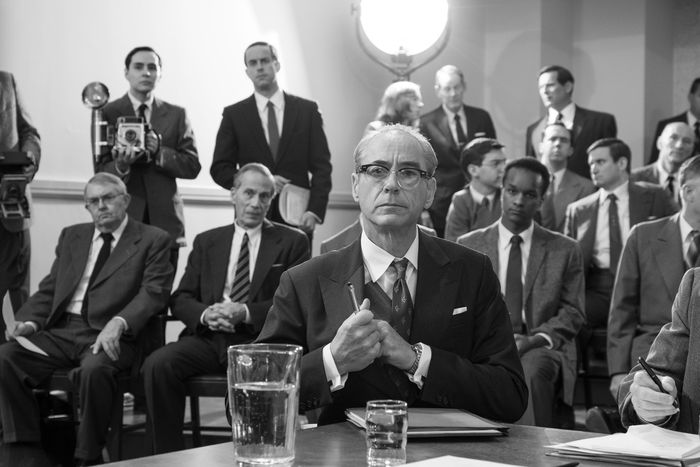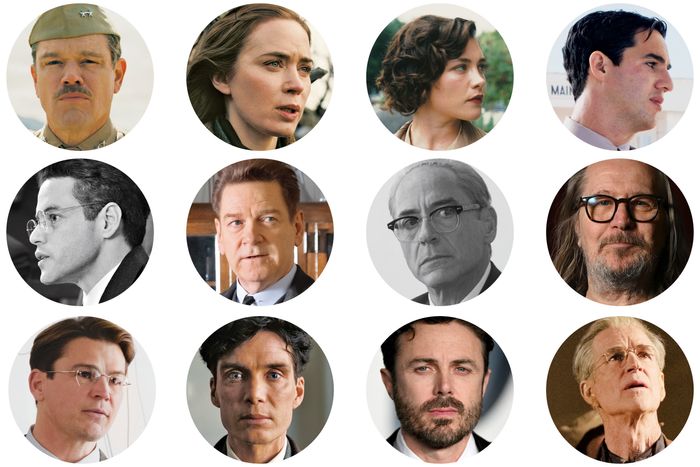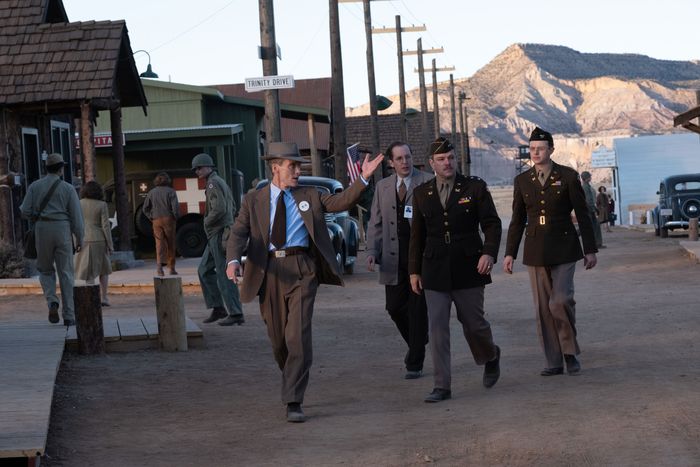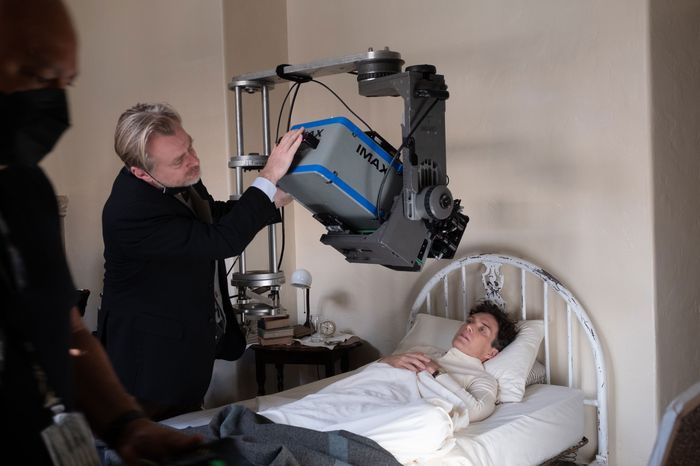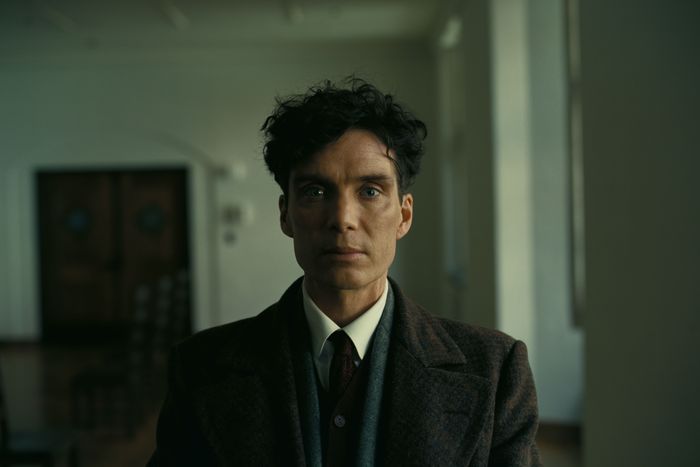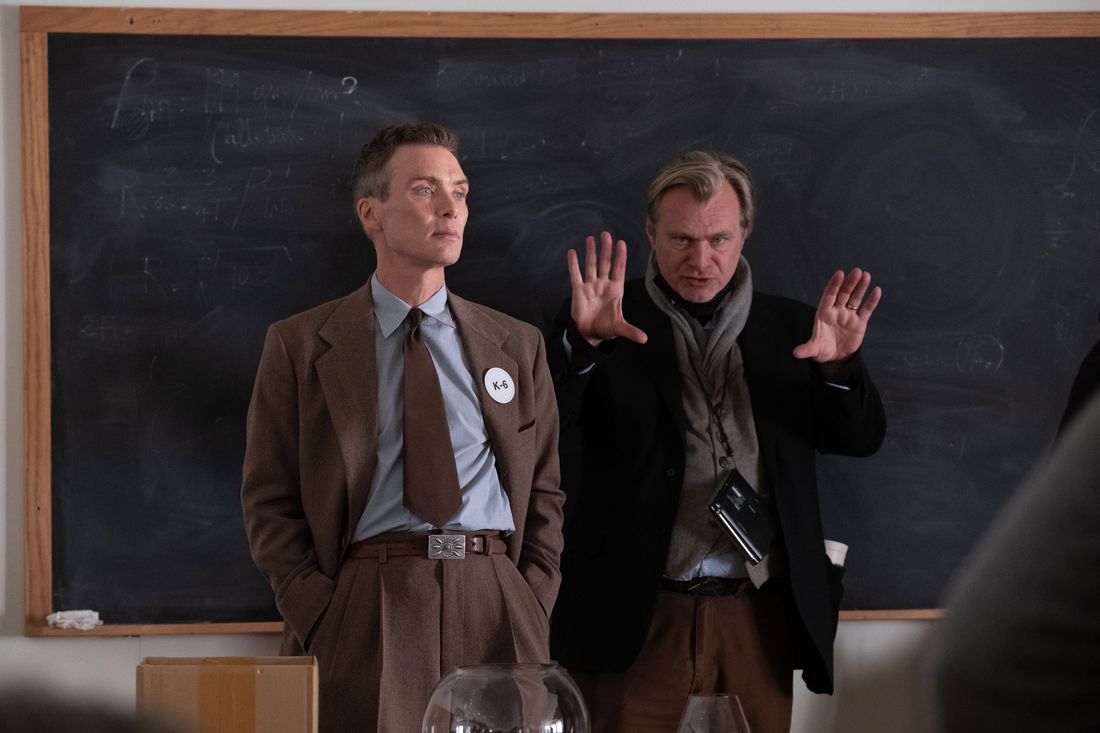
This article was originally published on July 17, 2023. At the 96th Academy Awards, Oppenheimer won seven Oscars including Best Picture.
Christopher Nolan remembers when he first heard the name Oppenheimer. It was via the lyrics of Sting’s 1985 antiwar hit, “Russians”: “How can I save my little boy from Oppenheimer’s deadly toy?” Like many in his generation, Nolan was already obsessed with the end of the world; he recalls the camps and blockades at Greenham Common in the early 1980s, when thousands of women joined forces to protest the placement of cruise missiles in England, and the growing campaign for nuclear disarmament in Europe. “As impressionable young people, when we were 12 or 13 years old, we were convinced we were going to die in a nuclear holocaust,” Nolan recalls. “I think very much the way kids these days feel about climate change.”
We’ve managed to meet on a day that itself feels cataclysmic. Raging wildfires in Quebec have made their way down the Northeast and shrouded New York in an orange pall of smoke. We’re here to talk about Nolan’s new film, a biopic about J. Robert Oppenheimer, the so-called father of the atomic bomb. “Culture is a bit limited as to how many apocalypses they can worry about at one time, which is a problem because all of these things need attention,” Nolan says. “When I first told one of my kids about what I was working on with Oppenheimer, they literally said to me, ‘Well, no one really worries anymore about nuclear weapons and war.’ To which my response was, ‘Well, maybe they should.’”
“When you watch the movies, it’s very clear what’s preoccupying Chris at any given moment in time,” says Emma Thomas, Nolan’s wife and the producer of all his films. “When our kids were little, Inception reflected his preoccupation with the importance of family.” And as one’s kids get older, one becomes even more preoccupied with what their future will look like — or if they’ll get to have one. Thomas notes that their daughter Flora is among the extras in a convoy of people escaping the dust storms in Interstellar.
Oppenheimer might have seemed like an odd story to tackle in 2021, when Nolan started the film. Since the Russian invasion of Ukraine thawed the ghosts of the Cold War, it has felt blisteringly relevant. And making it took Nolan beyond his comfort zones. “Oppenheimer’s story and Oppenheimer’s spirit have hung over a lot of my work,” Nolan says. “To finally address it head-on, it’s just something that I felt ready to do now.”
1.
Oppenheimer Finds His Foil
Just about all of Nolan’s works could fit neatly into popular genres – superhero pictures, thrillers, war films, science-fiction adventures. Oppenheimer is something he’s never tackled before, and an unlikely summer studio release. It’s a historical drama, based on Martin J. Sherwin and Kai Bird’s Pulitzer Prize-winning 2005 biography American Prometheus, a 591-page tome that was the result of two decades of research and five years of editing. It might also be Nolan’s fastest-paced film, hurtling at a speed most blockbusters would envy — even though it’s packed with detail and is mostly a movie about scientists and politicians sitting in rooms talking. At times it feels like Nolan has managed to fit most of Sherwin and Bird’s massive book into the three hour and 9 second film, right down to the lime juice and honey mixture Oppenheimer dipped his martini glasses in.
Nolan needs an ironclad structure before he begins writing a script, so he spends months taking notes and drawing diagrams. The film is told largely from Oppenheimer’s perspective, and the director wrote much of the script in the first person. “I’ve never seen that done before,” says Matt Damon, who plays Lieutenant General Leslie Groves Jr., the Army officer in charge of the Manhattan Project. “Instead of ‘Oppenheimer walks across the room,’ it’s ‘I walk across the room.’ This was a way for him to signal that, Okay, this is what the movie’s going to feel like. It’s going to feel immediate.”
The first person Nolan shared the script with after Thomas was his visual effects supervisor Andrew Jackson, because he wanted to find a way to picture the things Oppenheimer was seeing in his head. “He was imagining things like subatomic particles, but very few of these things had been observed at that time,” says Jackson. To that end, the visual effects team went out early and filmed all sorts of experimental footage — artful ways of showing particles, waves, chain reactions, bursting stars, droplets of molten metal exploding. Nolan passed this footage on to composer Ludwig Göransson. “I saw how they did that splitting of the atoms, with this ultraviolet light,” recalls Göransson. “I was sitting in a dark theater seeing this huge screen and these lights swirling around, and I was like, Okay, this is what I want the music to sound like.”
Later, editor Jennifer Lame would cut some of this footage into the film alongside real world images of droplets, ripples, crackling fires, and breaking glass, to try and depict the way that Oppenheimer, in his own words, was “troubled by visions of a hidden universe.” These inserts, which eventually become more and more ominous, are a key visual motif in the film.
But while structuring the script, Nolan also realized that he had to bring in another perspective, in part because much of the film focuses on Oppenheimer’s troubles with the U.S. intelligence Establishment during the McCarthy period. He found that in the story of Admiral Lewis Strauss (Robert Downey Jr.), a former businessman and chair of the Atomic Energy Commission who took on an increasingly contentious role in Oppenheimer’s life after the war.
The relationship between Oppenheimer and Strauss reminded the director of the one between Mozart and Antonio Salieri in Peter Shaffer’s Amadeus: the brilliant, troubled mind and the petty, powerful man who both admired and tormented him. The film’s framing device interweaves Oppenheimer’s 1954 security-clearance hearing and Strauss’s 1959 Senate confirmation hearing to become Eisenhower’s secretary of Commerce — two mid-century American political battles that were huge news stories at the time. (The scenes from Oppenheimer’s perspective are in color, while those showing Strauss’s point of view are in black-and-white.)
“I challenged a little the Mozart-Salieri of it all,” Downey recalls. “I said, ‘I’m not sure in some ways that Strauss isn’t a bit of the hero here,’ which kind of raised an eyebrow on Chris. I half-jokingly challenged him on whether Admiral Strauss hadn’t done everything that any patriotic American would’ve done. And he said, ‘Well, this will be a wonderful ongoing dialogue. So, will you do the film?’”
2.
A Huge Cast of Familiar Faces
Any story about Oppenheimer has to also be a story of the many scientists who came together for the Manhattan Project — whom Thomas calls “the rock stars within the scientific framework of the day.” Nolan was adamant about not creating composite characters, and to make sure audiences could keep track, he wanted each figure to be played by not just great actors but also those with recognizable or distinctive faces. Rami Malek, who plays physicist David Hill, only appears in the film for several minutes, for example, and yet he makes a remarkable impression.
For Oppenheimer himself, a real rock star served as partial inspiration. Cillian Murphy says that the director would send him pictures of David Bowie from the late 1970s — “when he was so skinny and kind of emaciated but had these wonderful tailored suits with the trousers,” Murphy says. “That was the Oppenheimer silhouette.”
Of course, screen time wasn’t an issue for him; his character dominates the film. “I’ve played a physicist before, in a movie for Danny Boyle called Sunshine, so I must have resting physicist face,” Murphy says. “What became clear to me really quickly was that there’s no point in me trying to understand quantum mechanics. I don’t have the intellectual capability. My job is to go after the humanity.” Others arrived armed with a surprising amount of knowledge. Benny Safdie, who plays Edward Teller (now known as the father of the hydrogen bomb), studied nuclear physics in high school. “I was working with a physicist at Columbia University,” Safdie says. “I was doing cosmic rays. It is a deep passion of mine.”
Safdie, an acclaimed filmmaker himself, was stunned by how quickly Nolan and his crew were able to move through scenes of various physicists and politicians arguing, debating, and questioning. He recalls sitting in one location thinking, “We’re going to be here for a while because this is like seven, eight scenes, it’s a hundred people, it’s period. But we moved to a new location before lunch! I said, ‘I have no idea how you did that.’”
The constant hubbub of scientific activity is one of the engines of the film, and Nolan was determined to give his actors a lot of freedom to talk and move. “You look down, there’s no marks on the floor,” Downey says. “You wonder if you shouldn’t pace it up. And Chris says, ‘Don’t worry about that. That’s my problem.’”
Because everything in Oppenheimer moves so fast, Nolan and editor Lame later went through the film repeatedly for what they called “character passes” – watching each cut of the picture to make sure individual characters weren’t getting lost in the shuffle. Nolan likens it to making a bed and pulling on each corner of a sheet, or changing a tire and tightening lug nuts. “You have to tighten the corners opposite so that everything stays in balance.”
Many of the real-life figures had written books, so cast members came in with a broad sense of their lives. “I always like to empower the actors to try things if they have an idea,” Nolan says. “In the script, the scenes are very, very stripped down. So you have to push your actors to come in with a bigger sense of the world, and walk through the door into the scene knowing what they just said to the security guard outside or whatever coming in.”
The director points to a scene in the office of U.S. secretary of war Henry Stimson, played by James Remar, in which a group is picking targets for the atomic bomb. Remar learned that his character had honeymooned in Kyoto, and it’s a matter of record that the city was taken off the initial list of targets – but Remar and Nolan added a line about the honeymoon being one of the reasons why. “It has this bureaucratic quality of a group of men discussing massive destruction and how they’re going to do these awful things. And you’re suddenly seeing a human face to these negotiations,” Nolan says. “There are some nice awkward silences in the movie, and that’s one of my favorite.”
3.
Rebuilding Los Alamos
Oppenheimer, who was born and raised in New York, fell in love with New Mexico at a young age. “When I was a kid, I thought if I could find a way to mix physics and New Mexico, my life would be perfect,” the character says early in the film. He gets to do just that when he proposes that the heart of the Manhattan Project be situated in New Mexico on a sparsely populated mesa known as Los Alamos. To re-create the early days there, Nolan and his production designer, Ruth De Jong, initially avoided the real location, which still houses a research laboratory. “It’s got Starbucks, and it’s all modernized,” De Jong says. “Chris said, ‘I’ve scouted it. I’m not going there.’” Instead, they effectively built their own town near Ghost Ranch. (The film did, however, shoot some of its interiors in the original Los Alamos locations, including the house Oppenheimer and his family lived in.) They also employed a researcher to dig deep into files from the U.S. government and universities to find both literature and photos to guide their work.
But the research was the research. When it came time to building the actual town, Nolan wasn’t a stickler for authenticity. “He kept saying, ‘This is my western,’” De Jong says. “He really wanted a very natural world, a very honest world.” She looked at films like Once Upon a Time in the West, McCabe & Mrs. Miller, Heaven’s Gate, and The Wild Bunch as references as they were location scouting.
“I remember when I got to the middle of the desert and I saw a city, poured concrete foundation,” Safdie says of first encountering the impressive, working Los Alamos set. At the same time, Nolan wanted to have the freedom to move the camera and actors about, and to use forced perspective to make backgrounds seem bigger and more distant. “Look, Ruth, we designed this,” De Jong recalls Nolan saying to her. “You should just get a bunch of Home Depot sheds. No one will know. Clad them. And let’s get a bunch of prefab trailers and clad those.”
Among the non-Western titles Nolan shared with De Jong as inspiration: Andrei Tarkovsky’s 1975 classic Mirror. “Cinematographer Hoyte van Hoytema had introduced me to Mirror prior to making Interstellar,” recalls Nolan. “Other than the fact that it’s a great masterpiece, we found it very useful for looking at the use of elements and the use of textures.” The visions of nature and the subatomic world that Oppenheimer sees throughout Nolan’s film reveal the workings of the physical world, but they also gather metaphoric force as the picture proceeds. “Mirror is an incredibly rich visual tapestry,” Nolan says, “but also one in which elements are allowed to breathe in symbolic ways.”
4.
Large Format, Small Scenes
Some of Oppenheimer’s more spectacular moments feature simple, frame-filling close-ups of Murphy in Imax — something viewers are not used to because Imax was not designed for that. “You could never, ever put your camera as close as you wanted to your subject in order to get the close-up,” says van Hoytema. “So we started to build lenses that gave us that technical possibility to get much closer.” Kodak also created a black-and-white Imax film for the production.
Much of the cast was unprepared for how loud the cameras would be during intimate and dialogue-heavy scenes. Safdie remembers that when he first heard the roar of an Imax camera, he thought something had gone wrong and looked around to see if Nolan was about to call “Cut!” “It’s a machine that can pull 24 medium-format photography frames per second through a big gauge,” van Hoytema says. “And if you have a camera that sounds like a little diesel engine, it’s very hard to create some sort of very tender, sensitive, quiet, intimate moment.” Emily Blunt, who plays Oppenheimer’s wife, Kitty, notes that despite the deafening camera and the technical demands of individual scenes, Nolan almost always stands close to the actors, away from the monitor. “When you do the scene, he’s standing by the camera and he’s watching you. And he’s close. So you really feel you’re in it with him.”
5.
The Bomb and Beyond
Nolan’s filmography is replete with machines that must not be used: a cloning device built by Nikola Tesla in The Prestige; a citywide (and very illegal) sonar Batman creates out of Gotham’s cell-phone signals in The Dark Knight. Machines running on hidden knowledge that, if revealed, could upend the world. Often, of course, these machines are used, and the consequences are soul-destroying for the characters. But that’s fiction. In real life, there is no more vivid example of this than the atomic bomb.
To re-create the Trinity test explosion — the first time in world history that a nuclear weapon was detonated — the production had to walk a fine line between the documented footage and artistic interpretation. Visual-effects supervisor Andrew Jackson notes that because Nolan wanted to avoid using too much CGI, they chose to constrain themselves in terms of the materials they could work with. Special-effects supervisor Scott Fisher and his team used high explosives and fuel, mixed to give the shape of a mushroom cloud, and then slowed the footage down to make the explosion seem bigger. The explosion had to be not just impressive but expressive, something whose fearsome power could function as a culmination of Oppenheimer’s quantum visions and fuel his simmering terror and shame. “This thing they’re all trying so hard to achieve is horrific,” Jackson says. “They’re all striving for something that no one would want.”
6.
Prometheus Bound
In the wake of the atomic bomb, Oppenheimer became one of the most famous men in the world, and he eventually attempted to use his public profile to speak out against nuclear proliferation. But he doesn’t appear to have ever publicly expressed real regret or apologized for what happened at Hiroshima and Nagasaki. He was, it seems, partly in denial about the role he had played.
“The whole film is about consequences – the delayed onset of consequences that people often forget,” Nolan says. It’s another idea that has run through his work. “You are not necessarily confronted with the strongest or worst elements of your action in the moment.” This idea is built into the style of the film. For Oppenheimer’s central theme, Nolan had suggested to Goransson using the violin to capture the physicist’s anxiety. “There is something with the unease of the violin, a fretless instrument, and how you can go from the most romantic, beautiful tone in a split second to neurotic and heart wrenching, horror sounds,” the composer says.
At the same time, the protagonist’s emotional conflict often remains beneath the surface, presenting a challenge for the actor playing him — which is also what drew Murphy to the part. “The film actors that I’ve always loved are the ones that, if they think it, you can feel it,” Murphy says. “That stuff, almost inexpressible, kind of beyond language.” Much of Oppenheimer’s moral quandary unfolds silently, as subtle changes on the actor’s face. “He’s got such an enigmatic quality to what he does,” Blunt says of Murphy’s performance. “There’s the whole shadow of his life playing across those rather extraordinary eyes in every scene.”
Murphy recalls a note Nolan gave him early on during a scene in which Oppenheimer argues with Groves: “I guess I came in pretty hard on the scene a couple of times. Chris took me aside and said, ‘He’s not a boxer; he’s a chess player.’ He would use his intellect rather than his physical presence, always, in these situations.”
Damon feels that the note expresses not just Oppenheimer as a character, but Nolan’s whole approach to the film. “It’s a message from a director to an actor saying, ‘I’m going to bring the whole movie to you. You can be as little as you need to, and it’s going to work.’ When I’ve been in that kind of partnership with a director, where you’re the fulcrum for the entire movie, you can get smaller and smaller.”
That is in some ways the captivating paradox of Oppenheimer. It’s a massively ambitious film about perhaps the most significant event of the 20th century (or, as Damon’s character puts it, “the most important fucking thing to happen in the history of the world”). And yet at its center is a tense, quiet man, pulled on all sides by various forces, tortured by what he’s unleashed. It’s the very opposite of a Great Man biopic.
The film itself is terrified by Oppenheimer’s accomplishment, reflecting its creator’s own fears for our future. “I don’t want to make a didactic film ever,” Nolan says. “I don’t want to tell people what to think or send a specific message.” But he also admits that after his journey through Oppenheimer’s life and work, there’s “there’s an inescapable nihilism that creeps in with the underlying reality that he changed the world in a way that can never be changed back. There’s no real catharsis there.”
More on ‘Oppenheimer’
- Every Oscar Best Picture Winner, Ranked
- Ryan Gosling and Emily Blunt Break Up with Barbenheimer on SNL
- Fallout Is Barbenheimer: The TV Show



